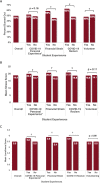Impact of the Early Phase of the COVID-19 Pandemic on Medical Student Well-Being: a Multisite Survey
- PMID: 35710675
- PMCID: PMC9202979
- DOI: 10.1007/s11606-022-07497-2
Impact of the Early Phase of the COVID-19 Pandemic on Medical Student Well-Being: a Multisite Survey
Abstract
Background: The COVID-19 pandemic drastically impacted medical student experiences. Little is known about the impact of the pandemic on student well-being and protective factors for burnout.
Objective: Assess US medical student burnout, stress, and loneliness during the initial phase of the pandemic, compare results to pre-pandemic data, and identify risk factors for distress and protective factors to inform support interventions.
Design: Cross-sectional survey of medical students conducted between May and July 2020.
Participants: 3826 students from 22 medical schools.
Main measures: Burnout (MBI-HSS), stress (PSS-10), loneliness (UCLA scale), and student experiences. Compared burnout and stress to pre-pandemic studies (2010-2020).
Key results: Of 12,389 students, 3826 responded (31%). Compared to pre-pandemic studies, burnout was lower (50% vs. 52%, P = 0.03) while mean stress was higher (18.9 vs. 16.0, P < 0.001). Half (1609/3247) reported high (≥ 6/9) loneliness scores. Significant differences were found in burnout and stress by class year (P = 0.002 and P < 0.001) and race (P = 0.004 and P < 0.001), with the highest levels in second- and third-year students and Black, Asian, or other racial minority students. Students experiencing financial strain or racism had higher burnout and stress (P < 0.001 for all). Respondents with COVID-19 diagnoses in themselves or family members had higher stress (P < 0.001). Nearly half (1756/3569) volunteered during the pandemic, with volunteers reporting lower burnout [48% (782/1639) vs. 52% (853/1656), P = 0.03].
Conclusions: While stress was higher compared to pre-pandemic data, burnout was significantly lower. Higher burnout and stress among Black, Asian, and other racial minority students and those who experienced financial strain, racism, or COVID-19 diagnoses likely reflect underlying racial and socioeconomic inequalities exacerbated by the pandemic and concurrent national racial injustice events. Volunteer engagement may be protective against burnout. Schools should proactively support vulnerable students during periods of stress.
Keywords: COVID-19 pandemic; burnout; medical student well-being; mental health; stress.
© 2022. The Author(s) under exclusive licence to Society of General Internal Medicine.
Conflict of interest statement
Authors have no conflict of interests to disclose.
Figures

References
-
- Whelan A, Prescott J, Young G, Catanese VM. Guidance on medical students’ clinical participation: effective immediately. Association of American Medical Colleges. Updated March 17, 2020; Accessed May 1, 2021. https://lcme.org/wp-content/uploads/filebase/March-17-2020-Guidance-on-M...
Publication types
MeSH terms
LinkOut - more resources
Full Text Sources
Medical

